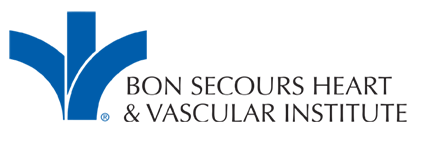
Providing the Full Continuum of State-of-the-Art
Cardiovascular Care in a Patient-Focused Environment
By Alex Strauss
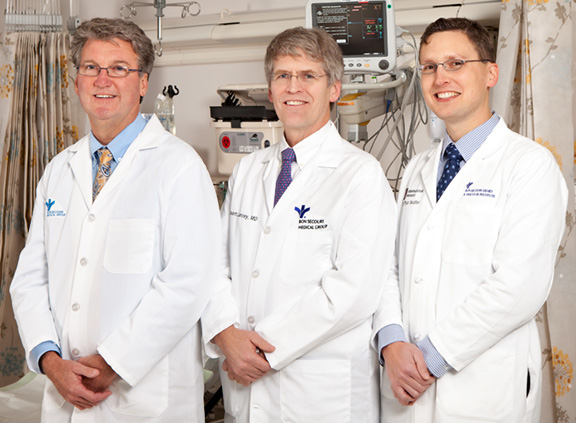
Diseases of the heart and blood vessels remain the number one killer of men and women in the U.S. From coronary artery disease and valvular dysfunction to blood clots, arrhythmias and congenital heart defects, successful treatment often depends on the experience and knowledge of a team of professionals dedicated to heart health. Such a team now exists in the Bon Secours Heart & Vascular Institute, a comprehensive program that provides world-class, highly-personalized cardiovascular care to residents of Hampton Roads.
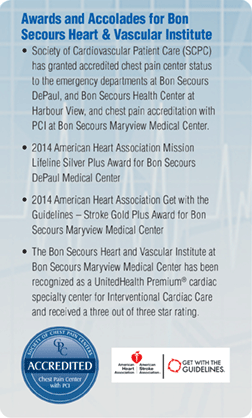 “We have a very patient-oriented program with the emphasis on focusing on what each individual patient needs,” explains Robert Lancey, MD, MBA, cardiothoracic surgeon with Bon Secours Cardiovascular and Thoracic Specialists and Medical Director of the Bon Secours Heart and Vascular Institute in Hampton Roads. “It’s a different mindset from many other heart centers. Heart care, in general, can tend to be very regimented. But here at Bon Secours, we address the needs of every patient personally, assessing their level of knowledge about the disease and providing them and their families with the highest level of care and service, even long after their procedure.”
“We have a very patient-oriented program with the emphasis on focusing on what each individual patient needs,” explains Robert Lancey, MD, MBA, cardiothoracic surgeon with Bon Secours Cardiovascular and Thoracic Specialists and Medical Director of the Bon Secours Heart and Vascular Institute in Hampton Roads. “It’s a different mindset from many other heart centers. Heart care, in general, can tend to be very regimented. But here at Bon Secours, we address the needs of every patient personally, assessing their level of knowledge about the disease and providing them and their families with the highest level of care and service, even long after their procedure.”
This personalized approach is made possible by a team of cardiologists, cardiothoracic surgeons, vascular surgeons, cardiac anesthesiologists, electrophysiologists, cardiac nurses, and support staff trained and experienced in all facets of heart and vascular care. The result of this level of specialization is not only a more personalized patient experience, but also better clinical outcomes.
The Bon Secours Heart & Vascular Institute features all of the components of a truly comprehensive program, including specialized cardiothoracic operating rooms, a cardiovascular intensive care unit, step-down telemetry beds, a cardiovascular recovery unit, an brand new electrophysiology lab, a non-invasive cardiac imaging center, and state-of-the-art digital cardiac catheterization laboratories located throughout Hampton Roads where doctors perform a range of groundbreaking (and often minimally invasive) procedures.
Off-pump heart surgery, mitral valve repair, biventricular pacemakers, laser lead extraction, cryoablation for atrial fibrillation, fenestrated abdominal aortic aneurysm grafts, mechanical thrombectomy, and new approaches to heart failure are among the innovations being offered through the Bon Secours Heart & Vascular Institute. These services, as well as some of the most advanced diagnostic techniques available anywhere, are provided at locations across Virginia.
All Bon Secours Heart & Vascular Institute heart patients receive extensive education, before and after their procedures, as well as customized nutrition advice, follow-up care, and cardiac rehabilitation. “Our broad focus on patients and their health is really what sets us apart from some other heart programs,” says Dr. Lancey. “It is nice to be able to do a complex operation, but what we really want to do is make sure that our patients leave healthier and can maintain that health going down the road. The procedure is just the start.”
Cardiac Surgery Advances at Bon Secours
Few devices have been as important to the advancement of cardiac surgery as the cardiopulmonary bypass pump, or the “heart-lung machine”, which was first used on a human patient in the 1950s. By temporarily taking over the functions of the heart and lungs to mechanically maintain the circulation of blood and oxygen, “the pump” allows heart surgeons like Dr. Lancey to operate on a still, rather than beating heart. While this can be critically important, the pump is not without its problems.
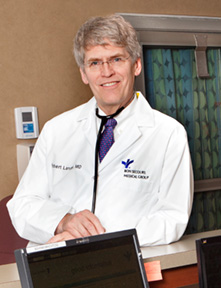
– Cardiothoracic Surgeon
“The heart-lung machine is a great device but it does tend to bring some trauma to the operation that makes it less than ideal for older or sicker patients,” says Dr. Lancey. For this reason, Dr. Lancey performs both on-pump and off-pump or “beating heart” coronary artery bypass procedures. “During an off-pump operation, , we use specialized instruments, one of which is a suction cup that attaches to the heart and allows us to lift it up so that we can access all of the blood vessels,” says Dr. Lancey. “A second device that looks like a two-pronged fork with suction cups is used to stabilize the area around the vessel. The first device allows us to visualize and the second to stabilize.”
Dr. Lancey, who is Board certified in both thoracic and general surgery, completed residencies in both at the University of Massachusetts Medical Center and trained in heart transplantation at Harefield Hospital in England before joining the faculty of the University of Massachusetts where he helped pioneer off-pump heart surgery in the 1990s. Dr. Lancey joined Bon Secours in 2013 and today uses off-pump surgery on his most at-risk patients. Patients who undergo off-pump heart surgery tend to need fewer blood transfusions, have fewer heart arrhythmias, may leave the hospital sooner, and generally heal faster, returning to daily activities earlier.
Patients with leaking or stenotic mitral valves can also benefit from Dr. Lancey and his colleagues’ expertise in mitral valve repair. Although the team is also experienced in valve replacement, choosing repair over replacement when feasible has been shown to result in better long-term survival, better preservation of heart function, lower risk of complications such as endocarditis, and less need for anticoagulant medication.
“The key to successful mitral valve repair is to really study the echocardiogram to get a clear mental picture of what the valve looks like and why it is leaking,” says Dr. Lancey. “If you really understand what is going on, then, when you do go in, you will be able to expeditiously repair the malfunctioning segment and put in the cloth ring that that will help the edges catch the blood better.”
Regardless of the type of surgery a patient undergoes, Dr. Lancey says the team is “very involved” in post-operative care. “A lot of folks just operate and send them home and that is it. But we see all of our patients a week after surgery and then 30 days later, and even call them at home during their recovery. We are very dedicated to making sure they stay healthy,” he says.
New Treatments for Arrhythmias
In some cases, the problem that brings patients to the Bon Secours Heart & Vascular Institute is not as much structural as it is functional. When the issue is electrical in nature, it may be referred to electrophysiologist Ryan Seutter, MD. Dr. Seutter was originally trained as an electrical engineer.
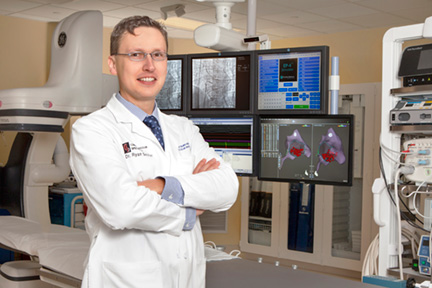
– Cardiac Electrophysiologist
“I dealt a lot with the electricity of other things so, when I became a physician, it just made sense to apply my previous knowledge of electrical engineering and electronics to the heart,” says Dr. Seutter. Dr. Seutter earned his medical degree at the University of Minnesota Twin Cities Medical School, where he also completed an internal medicine residency. He was fellowship-trained in cardiovascular disease at Baylor College of Medicine and in cardiac electrophysiology at the University of Minnesota and is Board certified in internal medicine, cardiology, cardiac electrophysiology, nuclear cardiology and echocardiography.
As an electrophysiologist with Bon Secours Cardiovascular Specialists, Dr. Seutter works in three primary areas: pacemakers and ablations for arrhythmias, and defibrillators for atrial fibrillation. Bon Secours Heart & Vascular Institute offers the newest and most advanced types of pacing devices and defibrillators and new cryoablation technology to treat arrhythmias where procedural precision is especially important.
The first step in the targeted treatment of electrical dysfunction in the heart is a precise diagnosis. Dr. Seutter utilizes a highly-sophisticated tool called “heart mapping” to help him locate the source of electrical problems. “Heart mapping is like GPS for the heart,” explains Dr. Seutter. “It is a procedure where we maneuver wires and catheters inside the heart to try to find where those areas of abnormal rhythm are coming from. That allows us to ablate or eliminate them.”
For people with serious heart rhythm disorders, Dr. Seutter and his colleagues offer the latest advances in pacemaker technology – the biventricular device. Biventricular devices or biventricular pacemakers have 2 or 3 or even 4 lead wires that can be positioned in the right atrium, the right ventricle and the left ventricle for a more targeted treatment approach than previous generations of pacemakers.
“We offer a full range of different types of wires, which allow us to pace from multiple areas of the heart,” says Dr. Seutter. “These devices give us a lot more flexibility in our treatment approaches, particularly for congestive heart failure.” Biventricular pacemakers have been shown to improve the symptoms of heart failure in about half of patients who continue to experience symptoms with medication.
Sometimes, problems with electrical devices arise and a permanent pacemaker or implantable cardiac defibrillator needs to be removed. Endocarditis (infection), severe malfunction or blockages in the veins may be indications for removal. Unfortunately, Dr. Seutter says, removing these leads, is no simple process. “You have wires that run up through blood vessels inside the heart, so you can’t just pull them out without doing damage,” he says.
To minimize the risks and address the technical challenges of device removal, Dr. Seutter now utilizes laser lead extraction, a less invasive and more effective extraction option. “With laser lead extraction, the laser actually forms a sheath around the wire, allowing us to cut and free it up as we extract it. Not only does this minimize the risk of damage, but it allows the patient to avoid open heart surgery.”
Advanced Vascular Treatments
Minimally invasive techniques are also a mainstay of Dr. Marc Camacho’s practice. Dr. Camacho is a vascular surgeon with Bon Secours Vein and Vascular Specialists, where specialists offer the full range of advanced vascular procedures. A graduate of Virginia Commonwealth University with a medical degree from Dartmouth Medical School, Dr. Camacho completed a residency in vascular surgery at the University of North Carolina at Chapel Hill and has been a part of the Bon Secours Heart & Vascular Institute since 2013. One of his most notable new procedures – rare but potentially life-saving – is fenestrated endovascular aneurysm repair.
“Fenestrated endovascular aneurysm repair is a minimally invasive alternative to an open procedure for certain types of abdominal aortic aneurysms,” says Dr. Camacho. “Where patients used to have to spend a week or two in the hospital and several weeks of recovery, with the fenestrated AAA graft, they can have the procedure and go home the next day.”
Endovascular repair using the fenestrated stent graft is specially designed to treat “short neck” aneurysms which extend above the renal arteries. Typically, surgeons need at least a 15 mm “neck” below the kidney arteries to place a graft with minimal risk for type 1A endovascular leaks. In the past, patients without this space above their aneurysm were not even considered candidates for surgery.
Now, the FDA-approved fenestrated stent graft makes treatment possible with customized holes that accommodate the arteries. The success of the procedure, which is performed through two or three small groin incisions, relies heavily on advanced 3D imaging technology for correct placement of the holes.
“We start by creating a 3D model of the aorta and then essentially stretching it out into a straight line so that we can perform exact measurements and compare where each artery is in relation to the celiac artery,” says Dr. Camacho. The measurements and CT images are sent to a lab in Australia to be manufactured. Three to five weeks later, the custom-made graft arrives and is ready for surgery. Although the average national time for this procedure is three-and-a-half hours, Dr. Camacho can typically complete it in three.
Blood clots, including deep vein thrombosis, are another common problem for vascular specialists at the Heart & Vascular Institute. Dr. Camacho and his colleagues use intravascular ultrasound to identify the precise anatomic reasons for a clot and determine the best ways to treat it. Many clots can be treated with clot-busting drugs, however, if the reason for the clot is anatomic, Dr. Camacho may decide to place a stent.
If the decision is to remove a clot, removal is now easier and faster thanks to a new type of thrombectomy that does not necessitate an overnight hospital stay. The new AngioJet thrombectomy system at Bon Secours uses high-velocity, high-pressure saline jets to create a vacuum effect in the vessel. It can be used to treat native coronary arteries and peripheral vessels and is regularly used to remove clots from dialysis shunts.
“The AngioJet thrombectomy device essentially sucks up the clot immediately, rather than leaving a catheter in place for 24 hours, waiting for TPA to work,” says Dr. Camacho. By reducing the amount of TPA needed to address a clot, the AngioJet can help patients avoid bleeding, one of the drugs most serious side effects.
Comprehensive Approach to Heart Failure
Interventional cardiologist William Callaghan, MD, a specialist in heart failure, is one of the Heart & Vascular Institute’s newest physicians, having joined the Bon Secours Cardiovascular Specialists team in January of this year. Although he is new to the Institute, he is not new to the area, or to heart failure. A native of Norfolk, Dr. Callaghan attended medical school at Eastern Virginia Medical School and did his fellowship in cardiology at the Medical College of Georgia. He launched and managed a community heart failure clinic in Augusta, Georgia which earned a unique advanced heart failure certification and hopes to eventually do the same for heart failure patients in Hampton Roads.
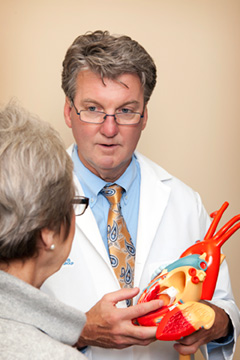
– Interventional Cardiologist
“Heart failure is very common,” says Dr. Callaghan. “It can be caused by many things – cardiomyopathy, a series of heart attacks, a virus, hypertension, even diabetes.” Regardless of the cause, the result is a heart muscle that is either too weak or too stiff to adequately circulate blood through the body. In addition to fatigue, symptoms can include congestion, swelling, and shortness of breath. If left untreated, it can lead to respiratory distress or kidney damage. Often, Dr. Callaghan says, heart failure cases are first diagnosed when a patient is hospitalized for something else.
“These patients may have been treated for bronchitis or some other problem a number of times and it is finally recognized when they are in for another problem,” says Dr. Callaghan. Medications, including diuretics, beta blockers and angiotensin-converting-enzyme inhibitors are mainstays of heart failure treatment. But Dr. Callaghan says truly effective long-term management of heart failure requires the kind of comprehensive approach offered at Bon Secours.
“What we try to do is get patients to the point where they can recognize when their symptoms get worse and take action. If they pick up three pounds, we tell them to take an extra fluid pill. We train them to limit salt in their diet. We try to treat this gigantic thing in a sort of low-tech way. This requires a lot of education.”
In some cases, the heart can be helped along in its work by a mechanical pump. A left ventricular assist device (LVAD) used to be seen only as a bridge to heart transplant, but improvements in these devices are allowing Heart & Vascular Institute doctors to use LVADs as destination therapy for some patients.
While it is not always possible to fully restore normal heart function in heart failure patients, Dr. Callaghan says it is almost always possible to slow down the progression of heart failure and improve quality of life. “It is really rewarding to see people turn around and begin to feel better,” he says. “Many of these patients come in very sick.”
Why Bon Secours?
While Bon Secours Heart & Vascular Institute physicians give a variety of reasons for choosing to work here, patient-focus is a recurring theme. Beyond the technology and the expertise, this patient-centered approach is demonstrated at Bon Secours in the form of heart healthy education, prevention and early detection efforts, careful post-procedural follow-up, nutritional counseling, patient navigators, rehabilitation and support groups, convenient locations and even same-day appointments in some cases.
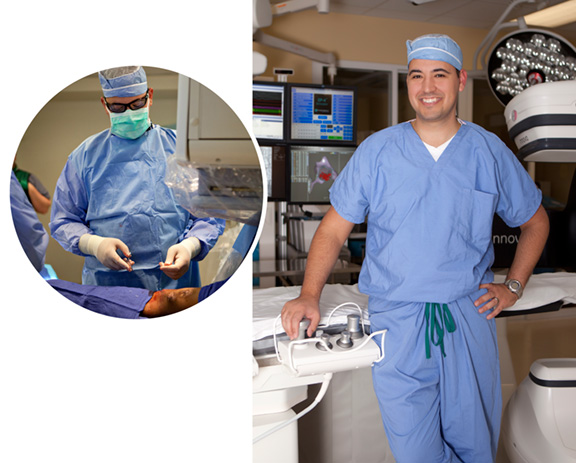
– Vascular Surgeon
“I really appreciate the more personalized approach that I am able to take at Bon Secours,” says Dr. Seutter. “Our size and structure makes it possible for us to stay with patients and see things through from start to finish. At the same time, we are large enough to give patients the advantage of advanced technology.”
Dr. Callaghan agrees, citing Bon Secours’ commitment to follow-through as a big reason for his move. “What I enjoy most is getting to know patients and working with them over a period of time. This is really critical where heart failure patients are concerned.”
“One of the great things about Bon Secours is that we offer everyone the best care, no matter what,” adds Dr. Camacho. “We can offer any and all vascular surgery options, but I am never going to offer you a surgery that you don’t need.”
Bon Secours demonstrates its commitments to community heart health through heart disease prevention programs, free seminars and free community cardiac screening events held throughout the year. A new Heart Health Academy, launched by Dr. Lancey in 2014, provides three-hour sessions on heart-healthy choices for middle school students in Hampton Roads. The program features pre- and post-session tests, nutrition quizzes, pedometers for students, videos of open-heart procedures, and a heart-healthy lunch.
Although the Heart Health Academy is aimed at students, Dr. Lancey says its message applies to everyone: Lifestyle changes can make a real difference in heart health, no matter when they are implemented.
“Obviously, a heart operation is a big event and it certainly catches peoples’ attention,” says Dr. Lancey. “But we encourage patients to see that event as the day they became a non-smoker, the day they changed their lifestyle, the day they changed their diet for good. Perhaps this is the moment in your life when you finally decide to start exercising. We are always excited to help a patient make that kind of positive change.”
For more information call
889-CARE (2273) or visit bshr.com/heart

